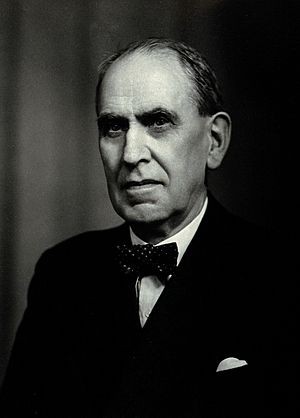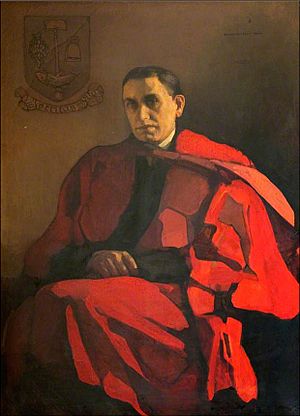Edward Provan Cathcart facts for kids
Edward Provan Cathcart CBE FRS FRSE (born July 18, 1877 – died February 18, 1954) was a famous Scottish doctor and scientist. He studied how our bodies use food, especially proteins. A special teaching position at the University of Glasgow, called the Cathcart Chair in Biochemistry, is named after him. He also worked with another important scientist, John Boyd Orr, on how humans use proteins. People also remember him for leading the Scottish Health Board Committee from 1933 to 1936. The Cathcart Committee, named after him, was very important for Scotland's part in creating the National Health Service after World War II. His friends said he lived "a life well spent helping people."
Contents
Life of a Scientist
Edward Cathcart was born in Ayr, Scotland, on July 18, 1877. His mother, Margaret Miller, came from a family who made metal parts. His father, Edward Moore Cathcart, was a merchant. When Edward was only nine, his father passed away. His mother then raised him and his two younger siblings.
He went to school at Ayr Academy. Later, he studied at the University of Glasgow, finishing his degree in 1900. After that, he traveled to Germany, visiting Munich and Berlin. There, he continued his studies in how bacteria cause disease and how body chemicals change when someone is sick. He was greatly influenced by a scientist named Carl von Voit during this time. From 1902 to 1905, he worked at the Lister Institute of Preventive Medicine in London.
Working at the University
From 1905 to 1915, Edward Cathcart taught about body chemistry at the University of Glasgow. This was called the Grieve Lecturer in Physiological Chemistry.
During World War I, he joined the Royal Army Medical Corps. He worked with the Anti-Gas Services, helping to protect soldiers from gas attacks. He became a high-ranking officer in this service. In 1917, he moved to a similar role for services at home. He eventually became a Lieutenant Colonel, directing medical services for the army.
After the war, he returned to the University of Glasgow. He became a Professor of Physiological Chemistry. From 1928 until he retired in 1947, he was the Regius Professor of Physiology at the university. This was a very important teaching position.
Awards and Honors
Edward Cathcart received many honors for his scientific work. In 1920, he became a Fellow of the Royal Society. This is a very respected group of scientists. In 1932, he also became a Fellow of the Royal Society of Edinburgh.
The University of St Andrews gave him an honorary doctorate degree in 1928. The University of Glasgow gave him the same honor in 1947.
He passed away at his home in Glasgow on February 18, 1954.
Important Roles
Edward Cathcart held many important positions throughout his career. These roles helped improve public health and nutrition.
- He led the Industrial Health Research Board. This group studied how to keep workers healthy.
- He was a member of the Medical Research Council. This council helps decide what medical research gets funded.
- He advised the Ministry of Health on nutrition. This meant he helped decide what foods people should eat to stay healthy.
- He was part of the Committee on Colonial Nutrition. This group looked at food issues in different parts of the world.
- He worked with several committees for the League of Nations. These committees also focused on nutrition around the world.
- He was a member of the Agricultural Research Council. This group studied how to improve farming and food production.
- He was a temporary director for the Hannah Dairy Research Unit. This unit studied dairy products.
- He led the Scottish Health Services Committee. This committee was very important for planning health care in Scotland.
- He represented the University of Glasgow on the General Medical Council. This council sets standards for doctors.
- He was part of the War Cabinet Scientific Committee on Food Policy. This group helped make sure people had enough food during wartime.
- He was a member of the Army Hygiene Advisory Committee. This committee advised on health and cleanliness for soldiers.
- He was part of the National Advisory Committee on Physical Training. This group promoted exercise and fitness.
- He was the Vice President of the Royal Society of Edinburgh from 1948 to 1951.
Family Life
In 1913, Edward Cathcart married Gertrude Dorman Bostock. She was also a student of physiology. She was only the third woman to graduate with a science degree from the University of Glasgow.
How He Was Remembered
A famous artist named Norah Neilson Gray painted a picture of Edward Cathcart in 1930.



